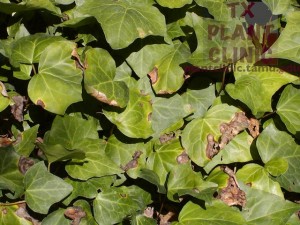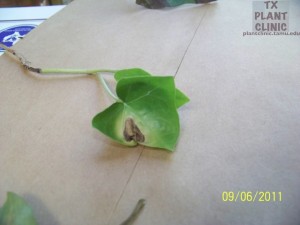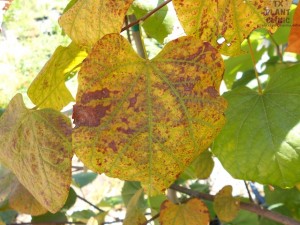Today is November 11, 2011 – the 11/11/11 day. This calls for a good ONE today!

This morning the temperature module outside my house in College Station registered 32°F. I guess it is really time for fall. One of the things that we usually see in the late summer and early fall is an influx of samples with all kinds of spots and/or blotches on them. Sometimes these spots/blotches are caused by one or more pathogen, and other times it is an environmental factor, or just a physical manifestation of the plant this time of the year. How to tell the difference?

Leaf spot on English Ivy
Fungal leaf spot – Look for evidence of the pathogen in the spot or at the edge of the spot. Typically, when you look at the leaf spot or blotch, you might see concentric circles. This is a clue that it might be a fungus. Look at the leave closely, if it looks bumpy (i.e. you see what looks like tiny blackheads). Sometimes, there may be “hair” sticking out – setae of Colletotrichum sp. A fungus that cause anthracnose. Sometimes you see nothing but still suspect that it might be fungal pathogen, stick you specimen in a container with a wet paper towel (not to touch the plant material) and leave it in room temperature for a day or two. In a couple of days, check to see if there is consistent fungal growth coming out from the leaf spot area. That can be a clue that the problem might be pathogenic.

Redbud showing damage due to water and nutrition. Ultimately, this sample was senescing albeit a little early.
The fall is also a time when we get a lot of panicked phone calls and email asking for help because their trees are dying. The symptoms are drastic: leaves turn color quickly and there is all there spots on it. Also, this is only happening to my redbud (or maple or oak or ash) only, it does not seem to appear on any of my other tree. Sometimes I get lucky and the person has multiple plants – where only one species of the plant is affected and not other types of plants. There could be many different things happening when you get these funky leafspots. Sometimes is can be fungal, sometimes bacterial, sometimes nutritional imbalance, and sometimes just plain senescences (aka general dying). Many times this will point to a problems that seems to be due to drought. When I see these sorts of symptoms, my inkling is to find out what is going on with the roots. The roots which function to bring up some nutrients and water, if damaged can result in symptoms such as scorched leaves and even tip die backs. This time of the year, trees will also begin to get ready for winter by shutting down (aka going into dormancy). Slowing down the function of leaves can also result in some funky leaf damage symptoms.
So DO NOT PANIC when you see really bad looking leaf spots on established trees or woody ornamental this time of the year. Take a close look to ascertain if the problem is of a pathogenic nature or a physiogenic nature or just part of the life cycle of the tree. On many plant, one might be able to see some new buds forming – ready to pop out in the spring. New buds are a good sign that tree or woody ornamental is still alive. Care for the plant, do not overwater and hopefully, the plant will put out new looking perfect leaves in the spring.



